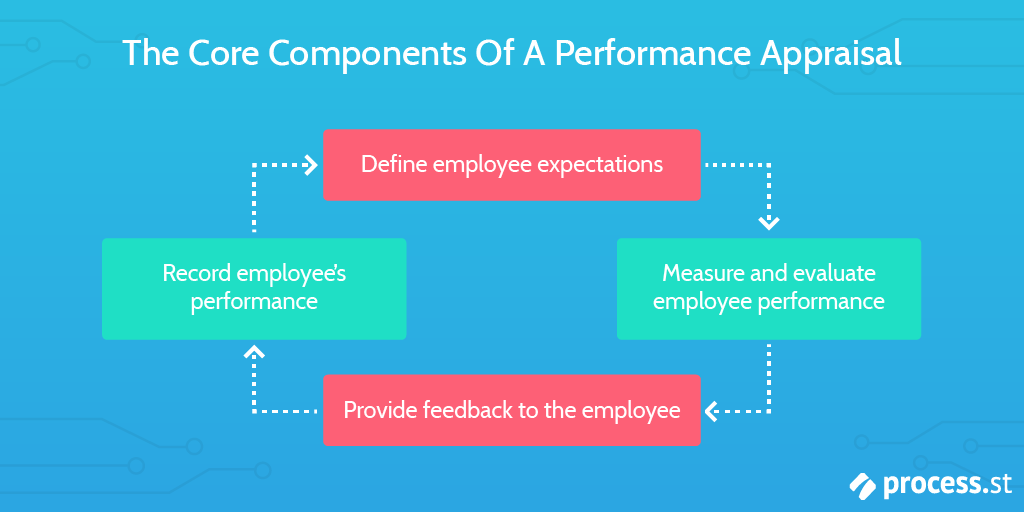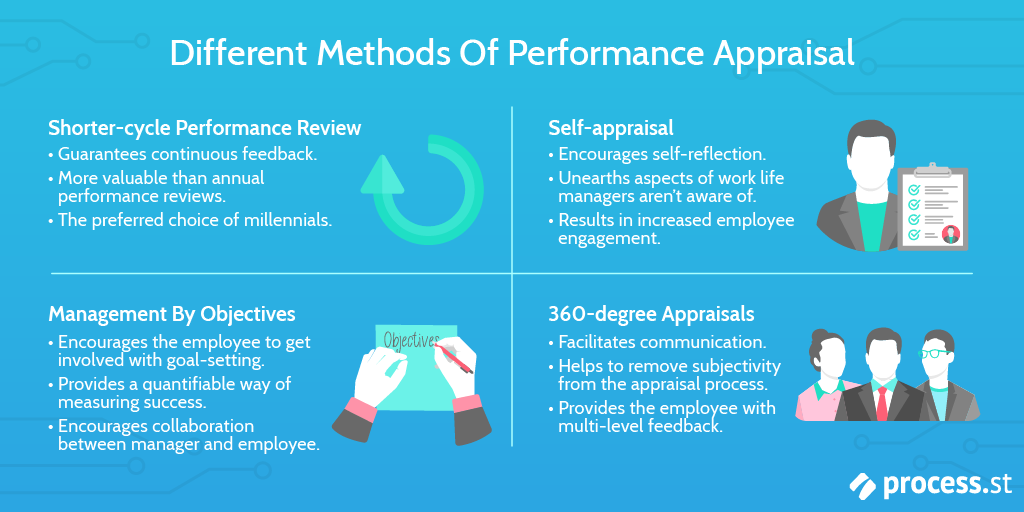
In this post, we’ll be looking at and learning about performance appraisal.
While we won’t be praising performances of global stars à la the judging panel of the Oscars or Golden Globes, we will be using performance appraisals to assess the conduct of the stars in your workplace.
After all, performance appraisals can be hugely beneficial.
For instance, 68% of employees who receive consistent, accurate feedback are more fulfilled in their jobs, in turn boosting employee engagement. Additionally, 92% of employees believe feedback – including negative feedback, if delivered appropriately – is effective for improving performance, resulting in increased employee output.
For performance appraisals to be successful, however, certain rules and procedures must be followed diligently.
Otherwise, the appraisal could backfire and have seriously detrimental results, including distrust and demoralization.
From a business perspective, this can be devastating.
So, to learn how to provide effective performance appraisals, read through the sections below:
- What is performance appraisal? And what are the objectives of performance appraisals?
- The different performance appraisal methods
- Why a performance appraisal needs to be done correctly
- Using Process Street’s performance review templates
Let’s begin.
What is performance appraisal? And what are the objectives of performance appraisals?
Performance appraisal – otherwise known as a “performance review”, “performance evaluation”, “employee appraisal”, or simply “PA” – is a formal assessment usually initiated by managers.
Performance appraisals, usually, have four core components. They are: Define employee expectations, measure and evaluate employee performance, provide feedback to the employee, and record employee’s performance.

By the end of the appraisal, the employee is not only given helpful feedback, but also provided with actionable ways to improve their skills and abilities.
A performance appraisal is a two-way street: When done correctly, a performance appraisal can leave the employee feeling more aligned with the company and more engaged. Meanwhile, the person conducting the review can be provided with valuable knowledge concerning the employee, their team, and the company-at-large.
But what, specifically, are the core objectives of an employee performance appraisal?
Understanding strengths
One of the major objectives of any appraisal is to unearth what the employee is doing well. The strengths could be in multiple areas, but each and every métier should all be noted down.
Once they have been noted, the strengths should be verbally expressed to the employee, so they clearly know which areas they’re excelling in.
Acknowledging weaknesses
Finding, acknowledging, and improving upon any weaknesses is a fundamental part of performance appraisal.
Although some employees may feel apprehensive about discussing weaknesses, it’s only through recognizing our shortcomings that we can better ourselves.
It’s for this reason that a performance appraisal is a perfect opportunity to inform employees of areas they could work on.
Assessing attendance and punctuality
Attendance and punctuality are two powerful indicators of how an employee is doing.
If they’re sometimes late to work but punctual once inside the office, they may need a gentle nudge to wake up earlier and work on their morning time management. However, if their attendance is lacking and they’re also not particularly punctual or performing well at work, that may be cause for greater concern.
Checking-in with the employee
A performance appraisal is inherently communicative. It encourages both the person or people conducting the review and the person being reviewed to discuss matters openly.
From a business point of view, having regular verbal contact increases productivity, manager-employee relations, and helps to establish great company culture.
Reviewing pay increases, promotions, or terminations
Performance appraisals can be used to inform the manager’s decisions regarding pay increases and job promotions.
Inversely, the information garnered from a performance appraisal can also sway the decision to let an employee go.
One of the reasons why some members of the workforce are fearful of performance appraisals is due to its linkage with employee termination. This is why the appraisal process must be communicated clearly to the employee, on top of having the process initiated regularly. An appraisal needn’t be fear-inducing if done correctly.

To realize the above objectives, and for you to garner the results you desire, the appraisal itself must be carried out properly.
As is written in Inc.’s business encyclopedia:
“All of these goals can be more easily realized if the employer makes an effort to establish the performance appraisal process as a dialogue in which the ultimate purpose is the betterment of all parties. To create and maintain this framework, employers need to inform workers of their value, praise them for their accomplishments, establish a track record of fair and honest feedback, be consistent in their treatment of all employees, and canvass workers for their own insights into the company’s processes and operations.” – Inc. Encyclopedia, Employee Performance Appraisals
Providing a successful performance appraisal, however, is easier said than done. But by utilizing any one of the lauded review methods, the process of implementing, providing, and sustaining performance appraisal is made easier.
The different performance appraisal methods

The eagle-eyed among you will notice there’s no mention of the traditional (read: annual) performance review.
Although the annual review is what historically comes to mind when hearing or reading “performance review”, it’s a process that is opposed by both managers and employees alike.
Findings by SHRM and Globalforce show that 45% of HR leaders believe that annual appraisals aren’t an accurate way to judge performance. To boot, 4 out of 10 workers are actively disengaged when they receive little to no feedback which means if a company is only performing yearly reviews, workers spend nearly the entire year disengaged.
Rather than persist with a process that no longer makes logistical business sense, some companies are moving forward with variations on the traditional performance review.
So without further ado, let’s jump into those other kinds of performance appraisals.
Shorter-cycle performance review
The shorter-cycle performance review has usurped the traditional review. While the shorter-cycle review may contain many of the same elements as the traditional annual review, it’s initiated consistently, rather than on a one-off basis.
Quarterly, monthly, and even weekly reviews guarantee useful, accurate feedback which the employee can make immediate use of.
And in a world which has radically changed since annual reviews were the norm – and with millennials becoming the brunt of the workforce and wanting more review-contact time (more on that later!) – a shorter-cycle performance review is more valuable.
Self-appraisal
Managers can’t notice all the areas in which an employee is succeeding, nor where an employee needs extra assistance.
This is why self-appraisals – sometimes referred to as “self-assessments” or “self-evaluations” – come in extremely handy. They unearth the aspects of work life that managers aren’t aware of.
In terms of process, an employee writes down their own strengths, weaknesses, rates their overall performance, and prepares discussion points so they can talk through the evaluation with their manager.
The result of self-appraisal is increased employee engagement, bolstered workplace culture, and it also helps to boost productivity.
Seeing as self-appraisals don’t cover the wide span that manager-led performance appraisals do, self-appraisals work best when used in conjunction with other methods.
360-degree appraisals
The 360-degree review involves a collection of people – not only the employee in question’s line manager – who provide feedback regarding the employee’s performance. The people involved are colleagues they work alongside, in addition to customers, and even clients who the employee has worked closely with.
The 360-degree review gets its name from its ability to take all points of view into account.
Despite more people being involved with the process, which some may find initially daunting, the 360 method is often hailed as one of the best ways to go about performance appraisal.
Due to the nature of multiple coworkers, customers, and clients being involved, it helps remove some of the process’ subjectivity, keeps biases at bay, facilitates communication, and provides the employee with multi-level feedback.
The 360-degree method is so well-regarded that 85% of Fortune 500 companies have incorporated it into their appraisal practice. However, the 360 review is a favorable alternative to the traditional annual review for businesses of any size and stature.
Management by objectives
With the management by objectives method, the clue is in the name: It’s a type of performance review which actively encourages the employee to get involved with goal-setting.
The manager and employee work together to set achievable objectives, goals, and todo lists. After a certain amount of time has elapsed, the employee’s performance and achievements – or lack thereof – is compared against the defined objectives.
Like all good reviews, the management by objectives method isn’t a lone event – it’s a process, and a more hands-on one, at that.
Ultimately, there’s no one-method-fits-all appraisal process. And for each company – ranging from a solopreneur to a company with a 6-figure headcount – the methods used will be different.
But for an appraisal to provide benefits for employees, managers, and businesses as a whole, it must be implemented properly.
Why a performance appraisal needs to be done correctly
Annual reviews don’t work.
Not only is having the build-up to an annual review daunting for many employees, but it’s also fundamentally flawed. Having just one review to discuss the entire ongoings over the past 12 months simply doesn’t cut the mustard.
Despite the inadequacies of annual reviews, the majority of companies – 69% – are still using annual and biannual performance appraisals. In fact, it’s lead to 22% of millennials calling in sick so they didn’t have to face their infrequent, sub-par appraisal.
It’s been widely reported that millennials – the largest generation in the U.S. labor force – actively want more contact time with managers and higher-ups, so they can gain a clear idea of where they stand and how they can improve. In a survey by TriNet, 85% of millennials said they would feel more comfortable in their role if they had more conversations and reviews with their managers.
This is why companies like Adobe have banished annual reviews completely, in favor of more frequent check-ins.
By having frequent contact time, managers can guide their employees better and help them should assistance be required. This results in better employee engagement and performance alike, not to mention improving the entire reviewal process.
To help both your business and employees to succeed with performance appraisals, you’ll need to undergo reviews frequently. That means quarterly reviews, at the least.

Another important factor to consider is the actual process of your appraisals.
At its core, performance appraisals are supposed to be valuable on multiple fronts, but a process cannot be valuable if the process itself doesn’t, well, work.
If the process isn’t up-to-scratch, not only is the process itself being failed, but the employees who are being subjected to a bad review process are being let down, too. Thus, negative attitudes toward performance appraisal are deepened.
As Joel Brockner, Professor of Business Management at Columbia Business School and author of The Process Matters: Engaging and Equipping People for Success, explains:
“Our findings show that, simply put, the process matters. Oftentimes, the performance review process can be viewed as uncomfortable, unfair and uninspiring. In order to improve upon the fairness factor and thereby better ensure employees accept the feedback, managers must acknowledge the individual identities of their workers and their specific contributions to the organization over time”. – Joel Brockner, Employees Receive Feedback Better When It’s Measured Against Their Past Performance Rather Than Their Peers
Seeing as the appraisal procedure is notoriously tricky to master (as complications like the ones Brockner mentioned could arise), it’s crucial to have a valuable, successful, and robust process you can use time and time again.
But how can your appraisal procedure be improved upon?
The answer is simple: Process improvement.
Process improvement is taking an objective view of the process and looking at each individual step to ensure that, overall, it’s effective. Think of it like a performance review for your own performance review process!
To help you dramatically improve the procedure, consider the list of core questions below:
- Does the person being reviewed know when the next appraisal will be?
- Is there a regular review cadence?
- Do you, as the reviewer, have ample written, oral, and statistical material to judge their performance?
- Have you given feedback on what they’re excelling in and what they could improve on?
- Does the person being reviewed know you’re there to help, support, and guide them in their role?
- Has good work been properly rewarded?
- Has review data been collected or stored in a reliable place? Is it easy to refer back to?
- Is the process standardized?
- Is the process effective? Could improvements be made? And if so, where?
On top of process improvement, you can also use BPM software such as Process Street to make the whole process easier.
By using Process Street specifically – which has a free template library, with an assortment of performance appraisal templates – the process is streamlined and standardized.
No more unstandardized internal reviews.
No more paper review notes getting stored in a cupboard and lost forever.
No more apprehension from your employees regarding what’s happening, why it’s happening, and when.
The review is tracked, the notes are documented, and the data is easy to refer back to as all completed checklists are archived.
And by using state-of-the-art tech to create, change, and complete the appraisal process, you’re not only saving time, but you’re also measuring performance in a professional, proper manner.
As Andre Lavoie, the CEO and co-founder of ClearCompany, rightly says:
“There is no need to have a lengthy review with an endless amount of questions and far too many competencies to achieve.
Instead, focus on questions that truly matter to the development of employees, such as, “In what area(s) would you like to improve, and how can I help you?” Additionally, narrow down competencies to set more realistic goals and avoid overwhelming employees. Finally, when possible, automate the process with technology. Doing so will aid in easily tracking and continuously measuring employee performance year over year.” – Andre Lavoie, Quell Employees’ Fears of Performance Reviews With These 6 Tips
To boot, you can even set up Zapier workflow automations with Process Street to help automate certain aspects of the appraisal process!
Goodbye, slow, ineffective employee reviews. Hello, brave new world.
Using Process Street’s performance review templates
At Process Street, we like to lend a helping hand to our customers and readers where possible.
Luckily for those interested in revitalizing their performance appraisal process, we have a plethora of free, easy-to-use templates you can use straight away.
If you’d like to add, remove, or change certain steps of the process, go right ahead. Hit the “edit template/checklist” button and edit the process until you’re confident with your procedure.
Performance review template
Performance review checklist
Customer service performance review
Employee performance review
Additionally, there’ll be times where you’ll want to edit, change, and reoptimize your appraisal process for maximum efficacy. Do this easily with our process for optimizing a process, which is embedded below.
The process for optimizing a process
If you prefer the DIY approach, you can build your own templates from scratch. Just sign up for a free account to create your process from the ground up!
Have you changed how you go about performance appraisals? And are there any appraisal tips that you advocate for? Let me know in the comment section below. You could be featured in an upcoming article!







Thom James Carter
Thom is one of Process Street’s content writers. He’s also contributed tech-related writing to The New Statesman, Insider, Atlassian, G2, The Content Marketing Institute, and more. Follow him on Twitter @thomjamescarter.